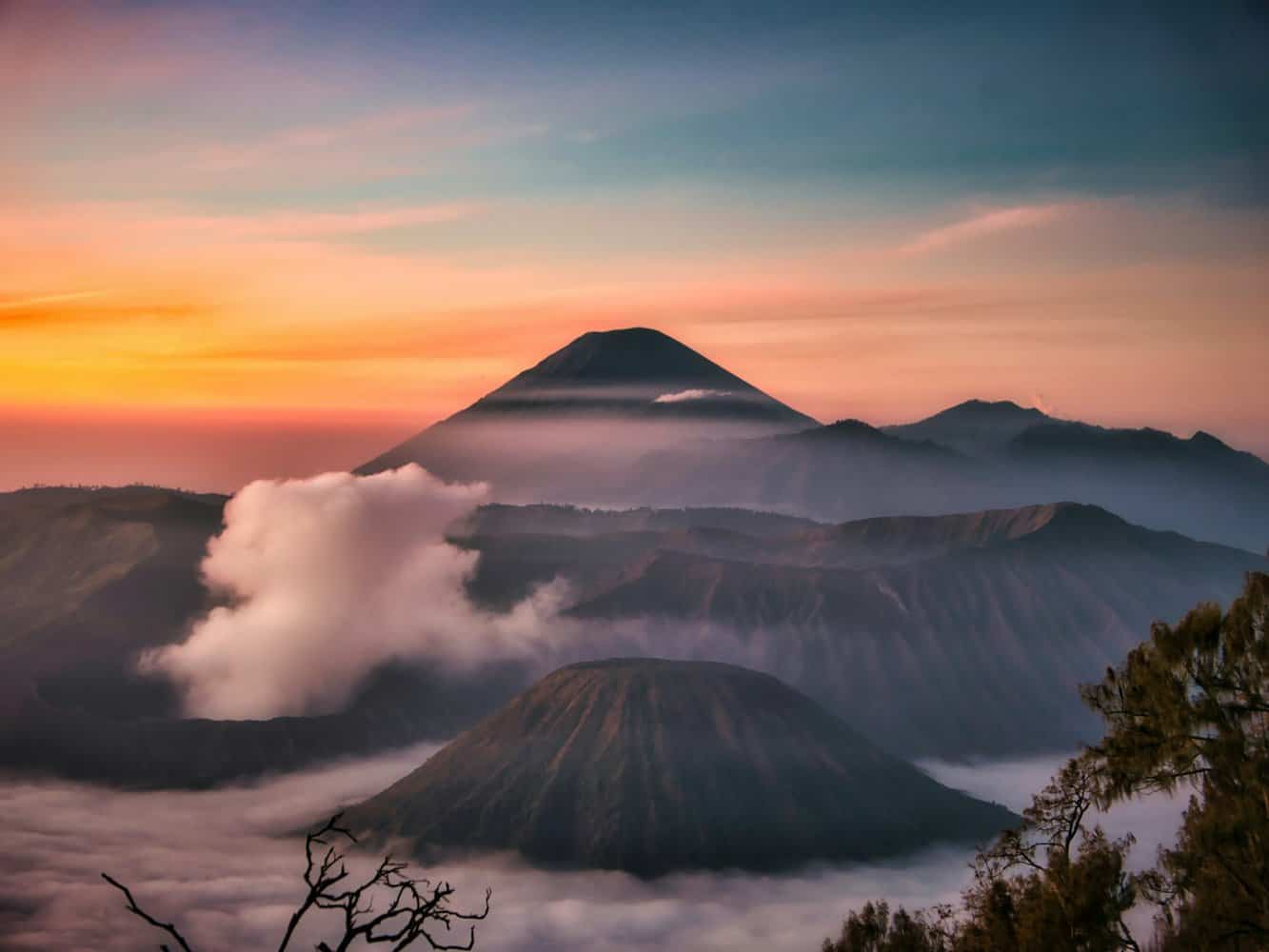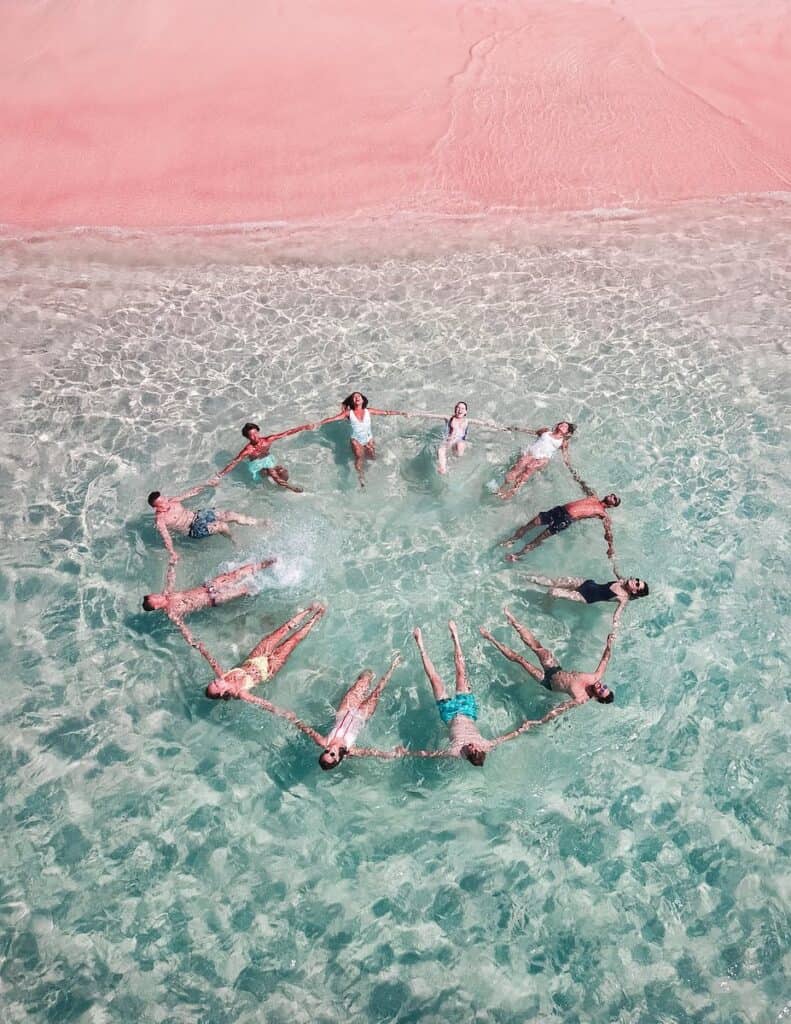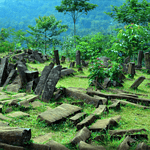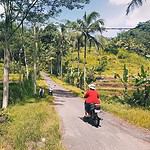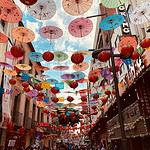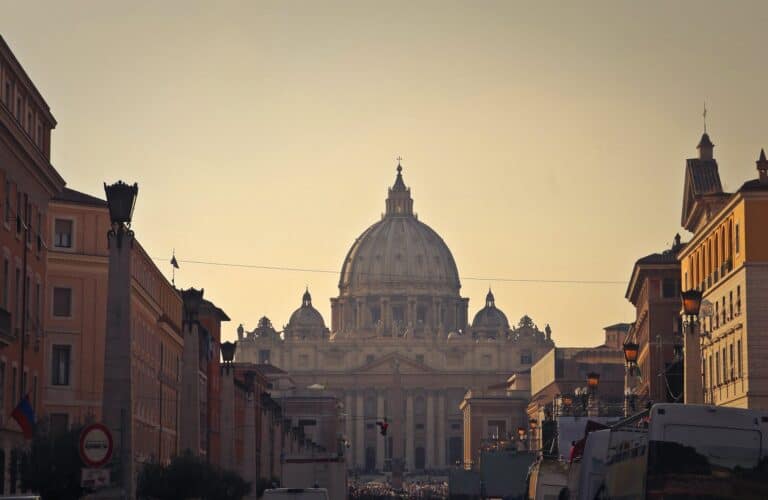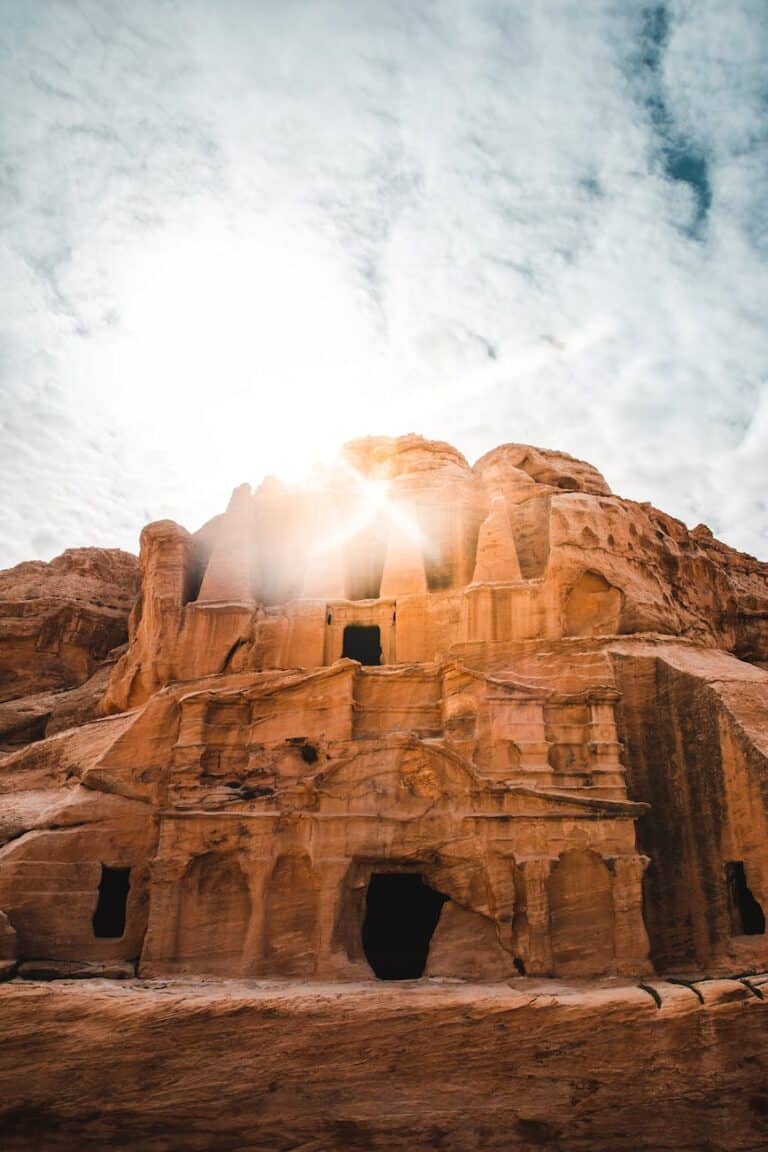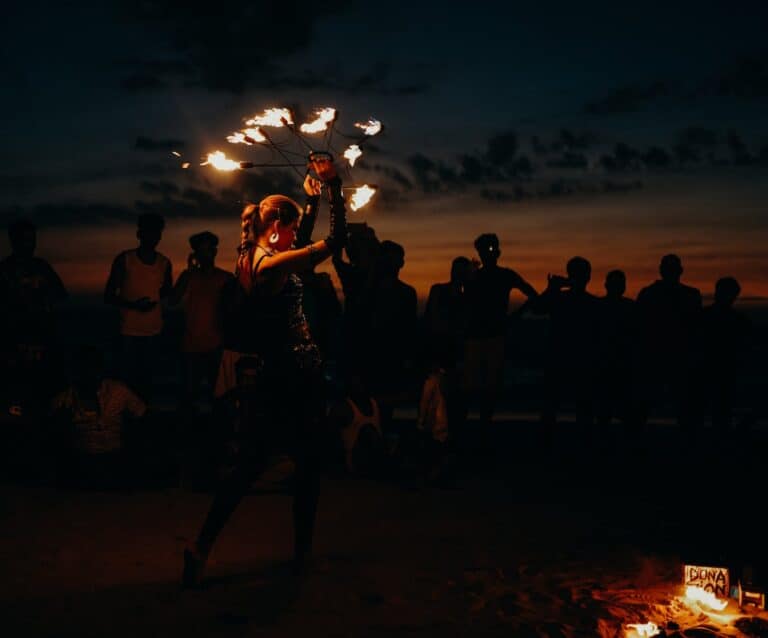East Java Itinerary: A Complete Guide to the Spectacular Volcanic Island 2024
Looking for the perfect East Java Itinerary for 2024? Then look no further!
In this guide, we have highlighted the diverse landscapes and the rich cultural tapestry of East Java, Indonesia, with travel tips, cultural advice, and the best places to stay!
Indonesia has a special place in my heart, so I love writing about it often. It feels like a home away from home for me. Java is one of my favourite islands in the world. Its diverse landscapes, ancient charm, and natural wonders still feel undiscovered by the travelling world in some ways.
From the historic city of Yogyakarta to the artsy streets of Malang and the jaw-dropping beauty of Bromo Tengger Semeru National Park, East Java is a playground for explorers!
Ancient temples tell tales of a bygone era, and vibrant street art leads to enchanting waterfalls and sunrise views over volcanic peaks. Electric blue flames of Ijen Crater and the stunning coast and beaches. Furthermore, incredible food and wonderfully kind and generous people! What more could you ask for?
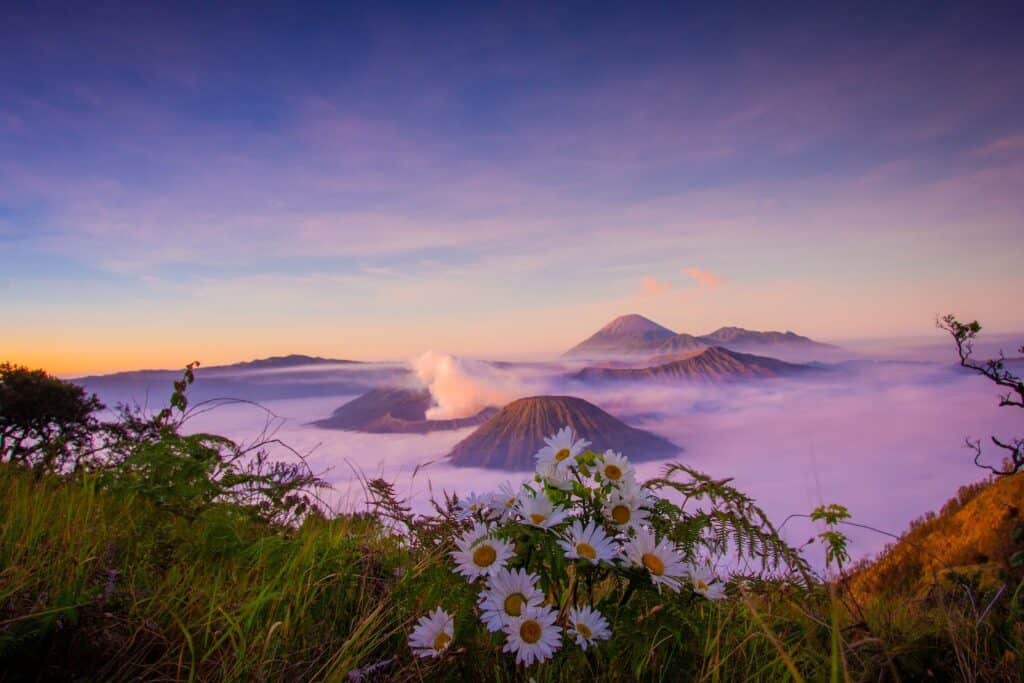
Indonesia Essentials
Indonesian VISA Info
Cheap Flights (SKYSCANNER)
Best Tours & Experiences
Best Hotels (Booking.com) / Hostels (Hostelworld)
Indonesian Pre-Paid SIM CARD
Best Nomad Travel Insurance! (Saftey Wing)
Table of Contents
Itinerary Map of Our East Java Adventure:
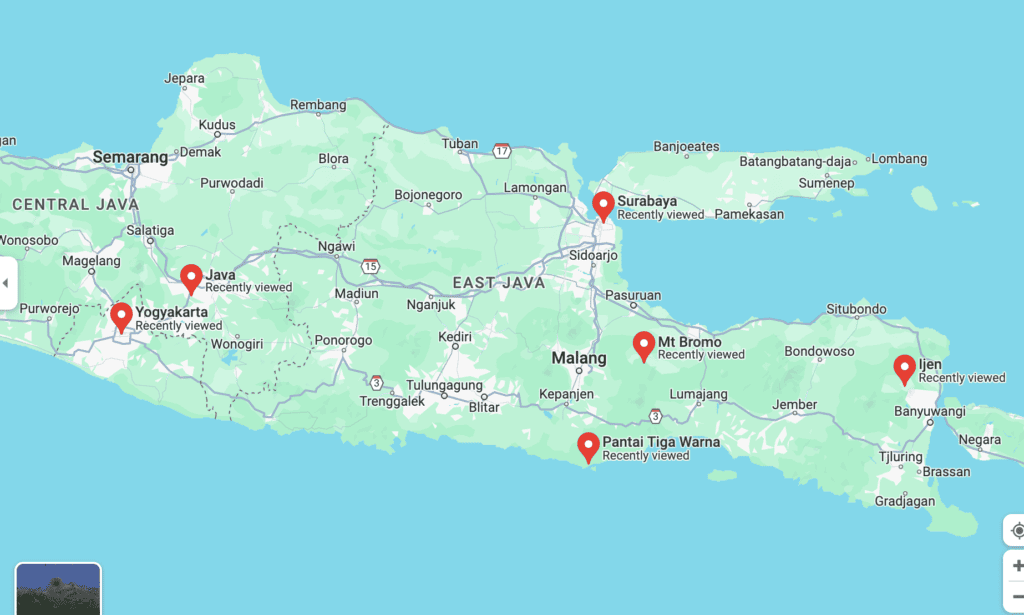
How Many Days Do You Need in East Java?
Java is not just a destination; it’s an invitation to experience Indonesia’s heart and soul in all its glory.
We spent eight days immersing ourselves in the best of East Java. Still, even with our fervour, countless hidden gems were left unexplored. For the avid traveller seeking a balance between adventure and relaxation, I recommend dedicating 7-14 days to East Java. Two weeks allow a more leisurely pace, ensuring a deeper connection with the region’s wonders.
Trust me when I say seven days is the minimum for an authentic experience. Anything less might leave you skimming the surface of popular destinations, missing the essence of the adventure.
Whether you’re there for a week or two, East Java promises a lifetime journey. Be warned, she will challenge you, but the beauty makes every moment worthwhile!
For those considering a trip to Java and wondering how to get from Java to Bali, it’s worth noting the various travel options available to enhance your adventure. Whether it’s a week or two, East Java promises a lifetime journey. Though be warned, she will challenge you; the beauty makes every moment worthwhile!

Javanese Culture – Must Try Experiences:
Wayang Kulit Puppet Show:
Experience the famous (and slightly terrifying!) cultural tradition of Wayang Kulit, a traditional Javanese puppet show that combines storytelling, artistry, and shadow play.
If you are as scared of puppets as I am, it might not be too enthralling; however, it wouldn’t be a trip to Java without attending! You can attend a performance in Yogyakarta or Surabaya to witness ancient tales come to life through intricately crafted leather puppets.
Batik Workshop:
One thing Indonesians know how to do is fashion and textiles! I’m constantly in awe of the traditional dress the women and men wear. (And the ability to stay calm in it all!)
I highly recommend indulging in the rich artistry of Javanese batik, a traditional textile technique. You can enjoy a batik workshop in Yogyakarta to create your masterpiece and learn about each design’s intricate patterns and cultural significance.
Gamelan Music:
Here, you can immerse yourself in the enchanting melodies of Gamelan, a traditional Javanese ensemble of percussion instruments. Attend a live performance to appreciate the rhythmic harmony that plays a vital role in Javanese cultural celebrations.
I saw a live performance at the Sultan’s Palace in Jogja, which they do daily, and it was fantastic, so be sure not to miss it!
Visit a Traditional Javanese Market:
Explore the vibrant atmosphere of traditional markets like Pasar Beringharjo in Yogyakarta. I love engaging with local sellers, sampling authentic snacks, and witnessing the daily life of Javanese communities.
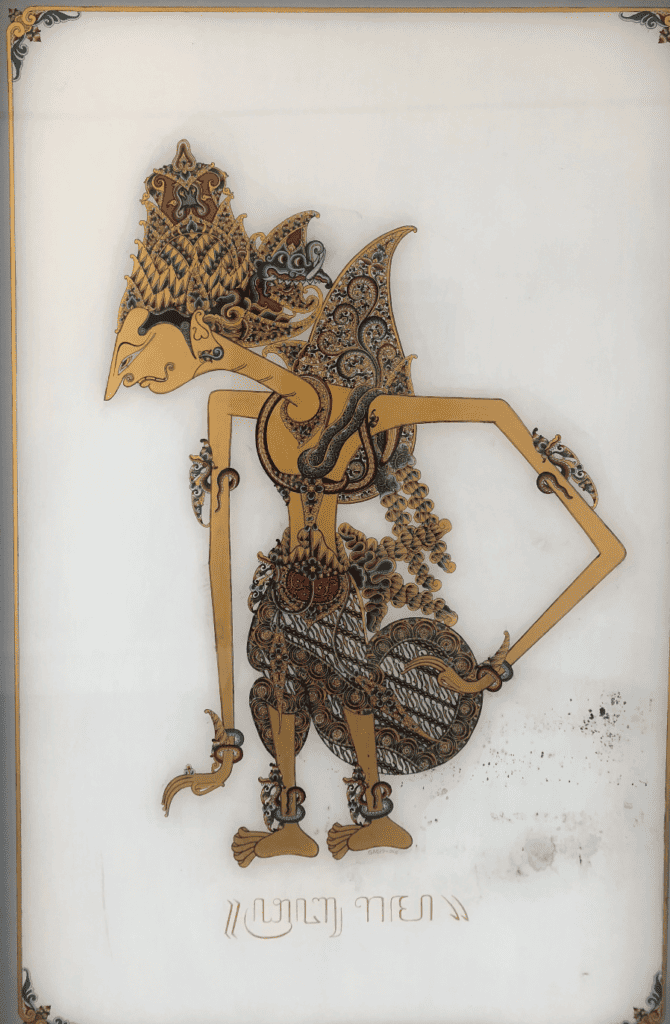
Javanese Customs & Travel Guidance
Before you jet off on your trip, let’s dive into some Javanese cultural customs and etiquette!
Respect for Elders:
In Javanese culture, respect for elders is deeply ingrained and highly valued. Using polite language and respectful gestures when interacting with older individuals is essential.
Giving precedence to elders in social situations is a common practice that underscores the importance of Javanese traditions and societal norms. This respect is a cornerstone of Javanese culture and reflects a broader commitment to maintaining harmony and honouring older and wiser people.
Modesty in Dress:
Adhering to Javanese customs, modest attire is highly encouraged, particularly when visiting religious sites or participating in cultural events. Traditionally, for women, this often means donning a kebaya, a traditional blouse paired with a sarong, a wrap-around skirt. However, for tourists’ day-to-day activities, cover your shoulders with a full-length skirt or pants.
Men are advised to wear long pants and a collared shirt. This emphasis on modesty respects Javanese cultural norms and aligns with the broader Indonesian values of decorum and decency. This practice is especially relevant for travellers exploring East Java and beyond, including Bali and its surrounding areas.
Greeting Customs:
The traditional Javanese greeting is a distinctive cultural practice that involves a slight bow with hands pressed together in a prayer-like position, known as “salam format.” This gesture reflects politeness and humility, integral to the social fabric of East Java and Indonesia as a whole.
Such customs are especially significant when engaging in Bali-to-Java transitions or when following a 10-day Bali itinerary that includes visits to East Java. Understanding and practising these greetings can enhance interactions and show respect for local traditions during your travels.
Religion:
Java is predominantly Muslim, and visitors should remember local customs during prayer times. Modesty in behaviour and dress is appreciated, particularly in religious settings.
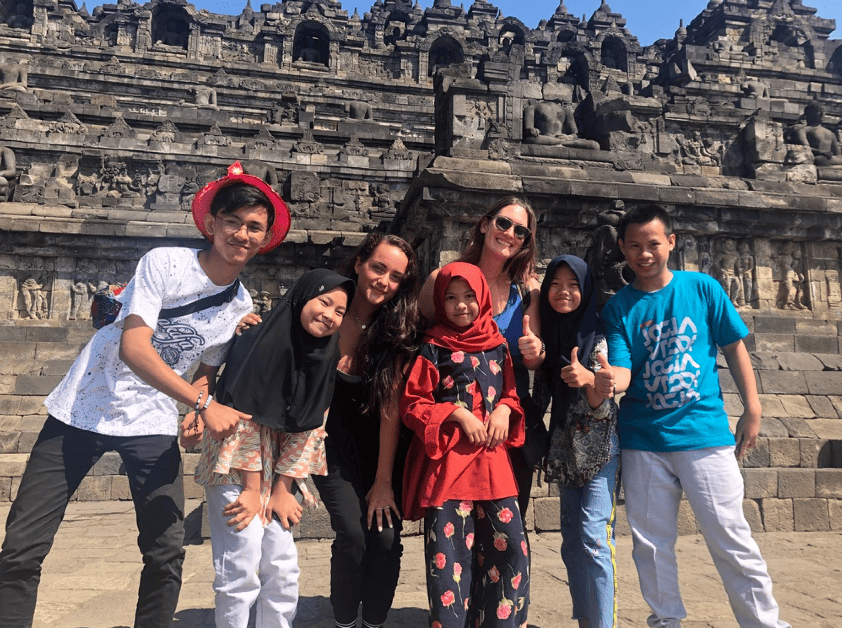
Costs of Travelling East Java
Flights from the USA and UK:
Let’s kick things off with the big-ticket item: flights. Depending on the season, airline, and flexibility of your dates, the cost of flying from the USA to East Java can range from $800 to $1,500.
If you’re jetting in from the UK, you’re looking at approximately £600 to £1,200. Pro tip: Watch for flight deals on Jacks Flight Club (or similar) and be open to mid-week departures for potential savings.
Accommodation Ranges:
Now, let’s talk about where you’ll rest your bones. East Java caters to all budgets. Whether you’re a backpacker or a luxury traveller, there’s a spot for you.
- Budget Hostels: $10 to $30 per night. Dormitory-style accommodations and cosy guesthouses are abundant, offering affordable options for the thrifty traveller.
- Mid-Range Stays: $40 to $100 per night. Enjoy a bit more comfort without breaking the bank. Mid-range options include boutique hotels and comfortable guesthouses.
- Luxurious Retreats: $120 and beyond. For those seeking the crème de la crème, indulge in upscale resorts and spa-like accommodations.
Food Ranges:
Fueling your adventures is crucial, and East Java doesn’t disappoint when it comes to gastronomic delights.
- Street Food and Local Eateries: $2 to $5 per meal. Dive into the local food scene with street-side treats and traditional dishes.
- Mid-Range Restaurants: $10 to $20 per meal. Enjoy a sit-down meal in charming restaurants, sampling a variety of Indonesian flavors.
- Fine Dining Experiences: $30 and beyond. Treat yourself to culinary indulgence in upscale dining establishments.
Activities: Temples, Hiking Tours, and More:
- Temple Entry Fees: $2 to $5 per temple. East Java boasts awe-inspiring temples like Borobudur and Prambanan. Entrance fees are a small price for a journey through Java’s ancient history.
- Hiking Tours: $20 to $50 per tour. Explore the breathtaking landscapes with guided hiking tours to Mount Bromo or Ijen Crater.
- Cultural Experiences: $10 to $30. Immerse yourself in local culture with dance performances, traditional ceremonies, and workshops.
Check out this incredible 3-day Bromo & Ijen Volcano Tour in East Java!
Daily Spending Estimate:
- Budget Traveler: $50 to $70 per day. This includes budget accommodation, street food, and exploring on a shoestring.
- Mid-Range Explorer: $80 to $150 per day. Enjoy comfortable stays, varied dining options, and a mix of budget and guided activities.
- Luxury Seeker: $200 and beyond. Indulge in lavish accommodations, fine dining, and exclusive excursions for an opulent East Java experience.
Must-Try Food and Drink in Java:
Nasi Campur:
Savour the iconic Javanese mixed rice, Nasi Campur, my absolute favorite meal of all time. Nasi means ‘rice” and campur means “mixture”. That’s because Nasi Campur is essentially a buffet window of lots of different dishes, including meats, tofu, tempeh, and styles of vegetables you get to choose from.
This dish is a staple in the culinary landscape of the Island of Java, offering an authentic taste of Java and Indonesia. Whether you’re exploring the bustling streets of Java island or enjoying a quiet meal in a local eatery, Nasi Campur is a must-try.
Prices range from 25k-60k depending on where you go, but the local haunts always serve the best flavours! I don’t go a day without Nasi Campur when I’m in Java, Indonesian!
Sate:
Indulge in Javanese Sate, skewers of grilled meat served with peanut sauce. Whether it’s chicken, beef, or lamb, this dish is a flavorful delight that reflects the rich culinary traditions of the Island of Java.
Java tourist spots often feature Sate as a highlight, showcasing its popularity and widespread appeal across the Island of Java. The blend of spices and the creamy peanut sauce make Sate a favorite among locals and tourists alike.
Gudeg:
Try Gudeg, a sweet and savoury dish made from young jackfruit, coconut milk, and spices. It’s a unique culinary experience that captures the essence of Javanese cuisine.
Often enjoyed in various settings across the Island of Java, Gudeg is more than just a meal; it reflects the cultural diversity found on this Java island. Whether you’re spending days on the east side of Java island or exploring other parts, Gudeg is a delightful treat that tastes traditional Javanese flavours.
Jamu:
Experience the traditional Javanese herbal drink, Jamu, known for its endless health benefits! If you start to feel unwell, Jamu and charcoal tablets will be your best friends in Indonesia!
Javanese Language Tips:
Learn Basic Phrases
When you travel to Indonesia, especially to places where people speak Javanese, it’s a good idea to learn some basic phrases. Even though many people in tourist areas can speak English, knowing a few words in their language shows you care about their culture.
For example, you can start your day by saying “Sugeng Enjing,” which means “Good morning.” If someone helps you, saying “Matur Nuwun,” which means “Thank you,” can make them smile. These little efforts make a big difference and can help you make friends!
Use Polite Language
Politeness is very important in Javanese culture. One simple way to be polite is to use the right words when talking to people. For instance, when you talk to a man, you can call him “Pak,” which means Mr. For a woman, you can say “Bu,” which means Mrs.
This small gesture shows that you respect them and their customs. So, if you meet someone named John, you can call him “Pak John.” If you meet someone named Maria, you can call her “Bu Maria.” It’s a small effort but it shows big respect. (This is only for elders, however!) Please do not use this for someone your age as it may be offensive. For someone your age or similar you can use “Mbak” (Pronounced Ba) for sister and “Mas” for brother.
Smile and Nod
In Javanese culture, a friendly smile and a nod can go a long way. When you smile at someone, it shows that you are kind and open to talking. It makes you seem friendly and welcoming.
Nodding your head a little when you speak to someone shows that you are paying attention and respecting what they are saying. These simple actions can make your conversations more pleasant and can help you connect with people better.
The 2-Week East Java Itinerary
Yogyakarta – Gateway to Java’s Culture:
Culture, tips and advice covered, let’s dive into the complete 2-week east java itinerary!
Yogyakarta, affectionately known as Jogja, serves as the cultural heart of Java. Steeped in history, this city boasts the grandeur of the Kraton, the Sultan’s Palace. It offers immersive experiences like the traditional Wayang Kulit puppet shows.
I loved Yogyakarta; it was a city with the architectural feel of a village. It had great food, great people, and so much to explore! I felt safe here as a solo female traveller, too!
Borobudur, the colossal Buddhist temple, and Prambanan, the magnificent Hindu temple complex, testify to the region’s diverse religious heritage. An East Java itinerary would not be complete without a trip to these famous and historic sites.
The bustling Malioboro Street beckons with its vibrant atmosphere and local craftsmanship, providing a perfect introduction to the enchanting spirit of Yogyakarta.
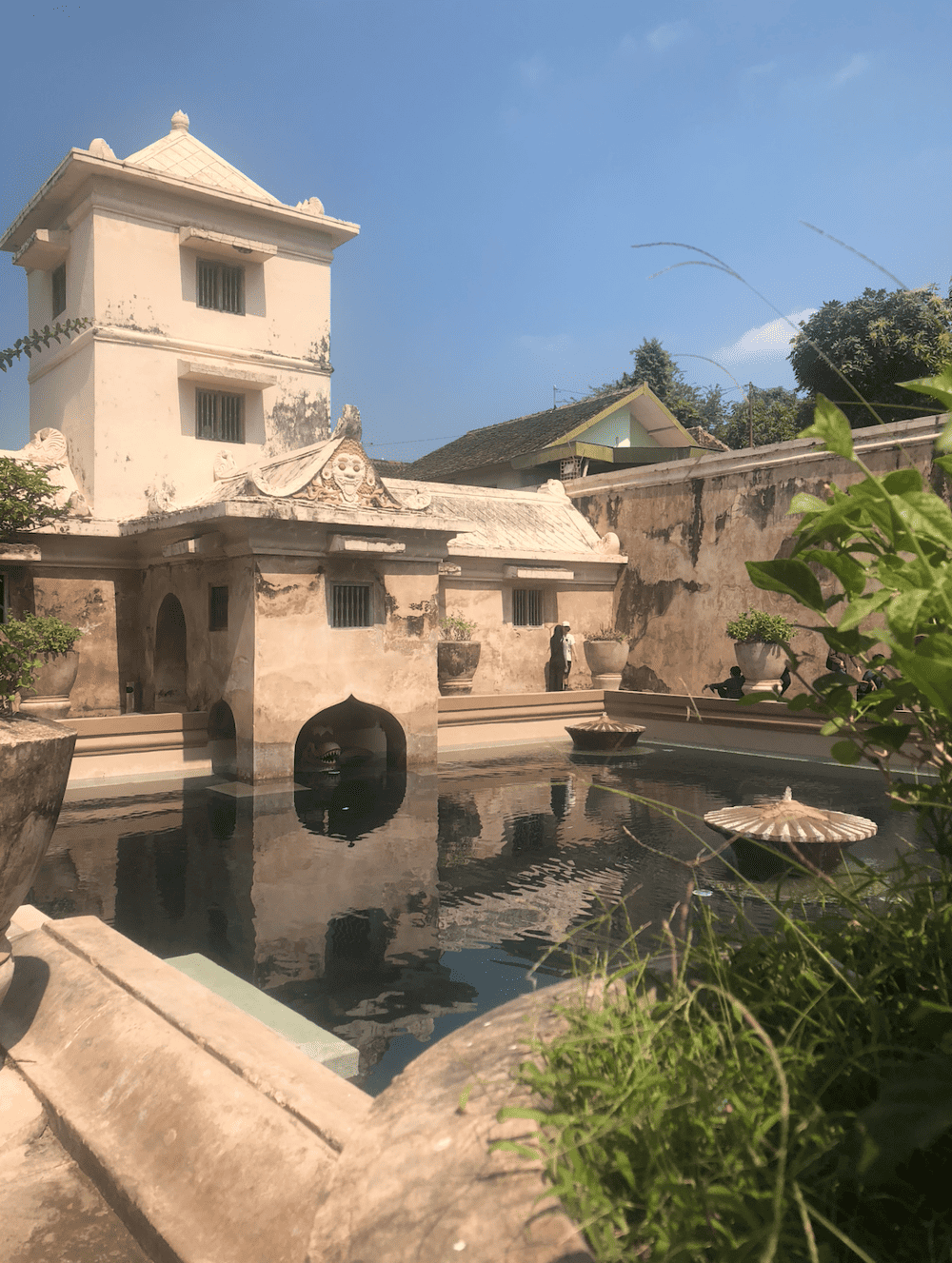
Accommodations:
– Luxury Option: The Phoenix Hotel Yogyakarta
– Budget Option: Wanderloft Hostal Jogja
Day 1:
- Morning. Arrive in Yogyakarta, the cultural hub of Java, and settle into your accommodation.
- Afternoon: Explore the Kraton (Sultan’s Palace) and the (Taman Sari) Water Palace to immerse yourself in Javanese history and culture.
- Evening: Attend a mesmerising shadow play, a traditional Wayang Kulit puppet show.
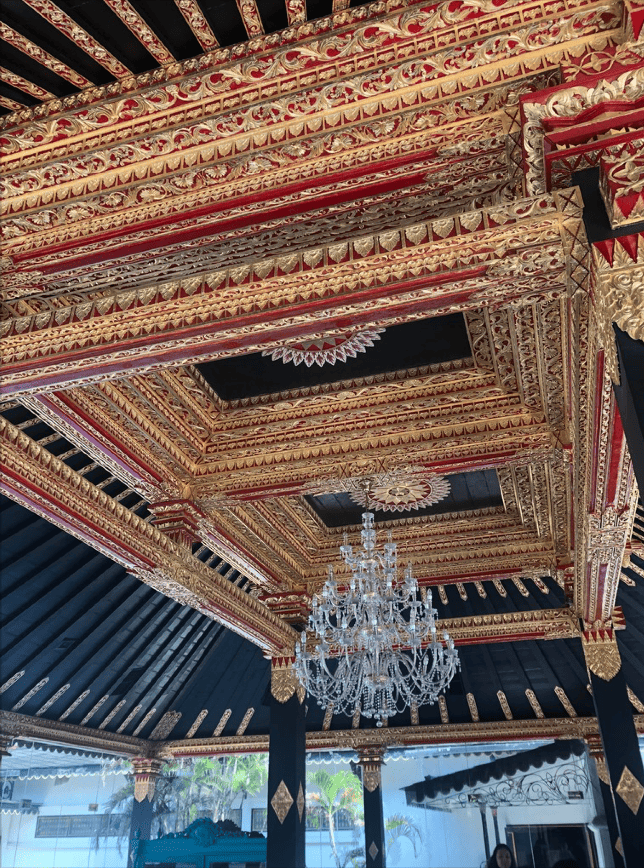
Day 2:
- Morning: Visit Borobudur Temple, the largest Buddhist temple in the world.
- In the afternoon, explore the nearby Pawon and Mendut temples.
- Evening: Return to Yogyakarta for a stroll down Malioboro Street.
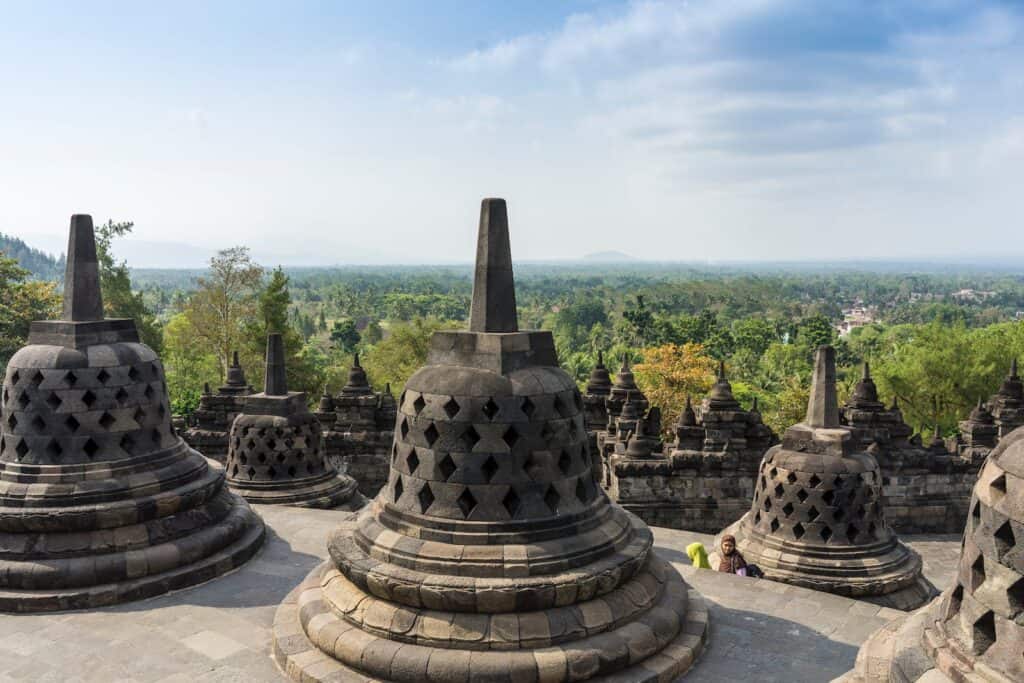
Day 3:
- Good morning. Discover the Prambanan Temple complex, a masterpiece of Hindu architecture.
- Afternoon: Participate in a Batik workshop to create your piece of traditional Indonesian art.
- Evening: Enjoy a serene dinner at one of Yogyakarta’s local warungs.
Borobudur Temple (Entrance: IDR 475,000):
- How to Get There: Fly into Adisutjipto International Airport (JOG) in Yogyakarta, then take a scenic 1.5-hour drive to Borobudur.
Prambanan Temple (Entrance: IDR 400,000):
- How to Get There: Prambanan is just a short drive from Yogyakarta. Use local transportation, hire a private driver, or take a tour. You can usually combine a time with Borobodur from Yogyakarta.
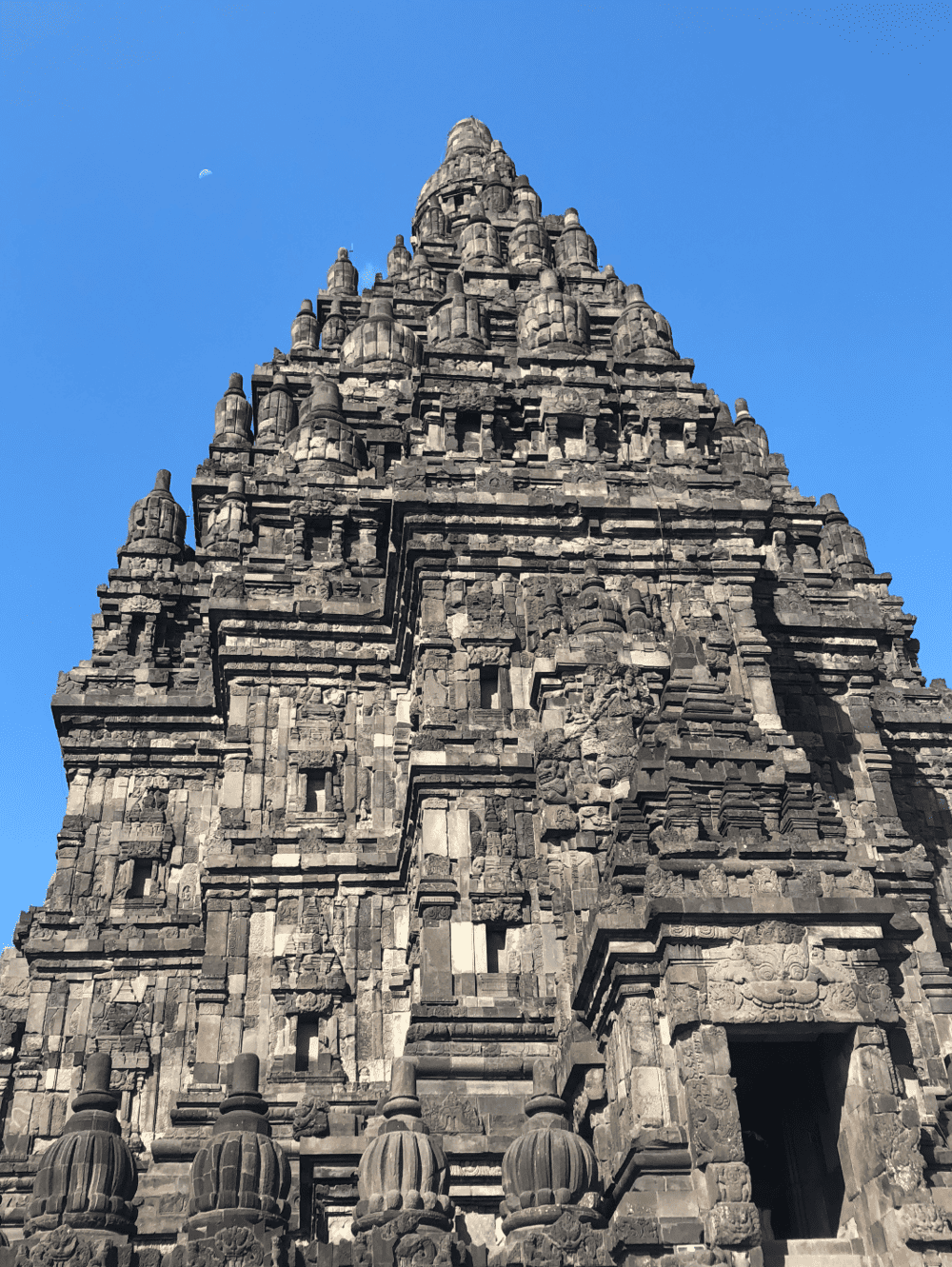
Surabaya – Gateway to Urban Dynamism:
Our journey now brings us to Surabaya, strategically situated in the north of East Java. As the gateway to the region, Surabaya offers a dynamic blend of modernity and Javanese tradition, making it an essential stop on our East Java adventure.
You can get trains super easily from Yogjakarta here and onwards into East Java, making it a great stop to explore the coast of northeast Java if you wish to do so!
Surabaya, affectionately known as the “City of Heroes,” is a testament to Indonesia’s resilience. Boasting a skyline of towering structures, it’s a metropolis that encapsulates the spirit of a new era in Java.
Accommodations:
– Luxury Option: Bumi Surabaya Resort
– Budget Option: Zest Hotel Jemursari
Day 4:
- Morning: Visit Pasar Atom, a vibrant traditional market.
- Afternoon: Explore the House of Sampoerna and enjoy local cuisine for lunch.
- Night: Pay homage at the Heroes Monument and Marvel at Al-Akbar Mosque.
Day 5:
- Morning: Explore Suramadu National Bridge. Capture morning views of the bridge.
- Afternoon: Stroll through the city centre. Enjoy a coffee break at a local café.
- Night: Delve into Javanese cuisine at a local warung.
Malang – Waterfalls and Cultural Vibes:
Up next on the East Java itinerary, a city very close to my heart, Malang! A city embraced by cool highland air is a haven for art lovers and nature enthusiasts. Also, If you are a foodie like me then Java is the home of Nasi Campur, my favourite Indonesian dish and Malang is a great place to try it!
Looking for a wonderful LOCAL female tour guide for Java? Then look no further than my friend Nuu! See her Tour Guide Insta Here!
Its streets are decorated with colourful murals, and Jodipan Village, with its vibrant, multi-coloured houses, is a visual feast for the eyes; I have never seen anything quite like this on my travels.
Tumpak Sewu, Coban Rondo and Coban Pelangi waterfalls, nestled in the surrounding mountains, are captivated by their natural beauty. Malang’s cultural vibes and artistic scenes make it a delightful stop, offering a perfect blend of modernity and historical charm.
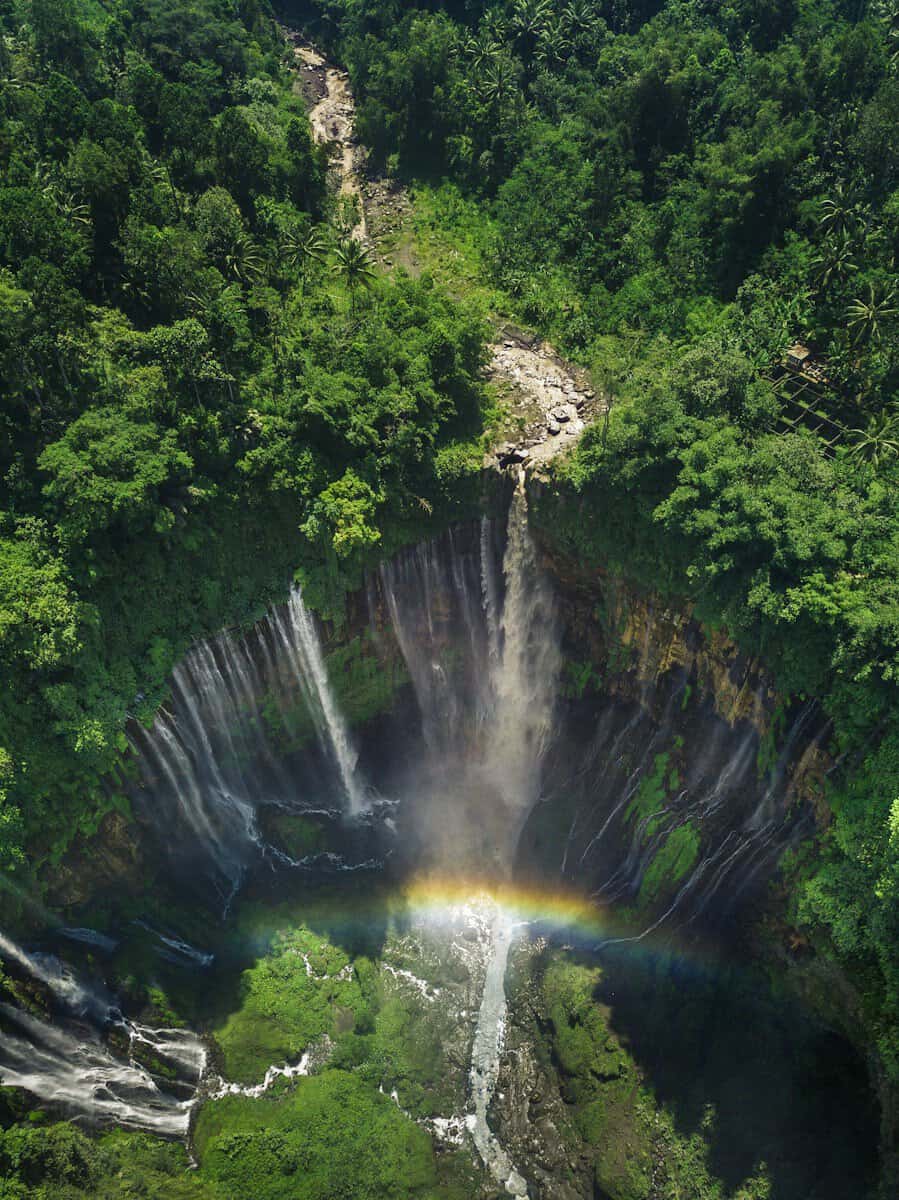
Accommodations:
– Luxury Option: Grand Mecure Malang
– Budget Option: Kertanegara Premium Guest House
Day 7:
- Morning: Visit Coban Rondo Waterfall, a mesmerising waterfall surrounded by lush greenery.
- Afternoon: Explore Jodipan Village, an Instagram-worthy village known for its colourful houses.
- Evening: Relax and enjoy the local culinary delights.
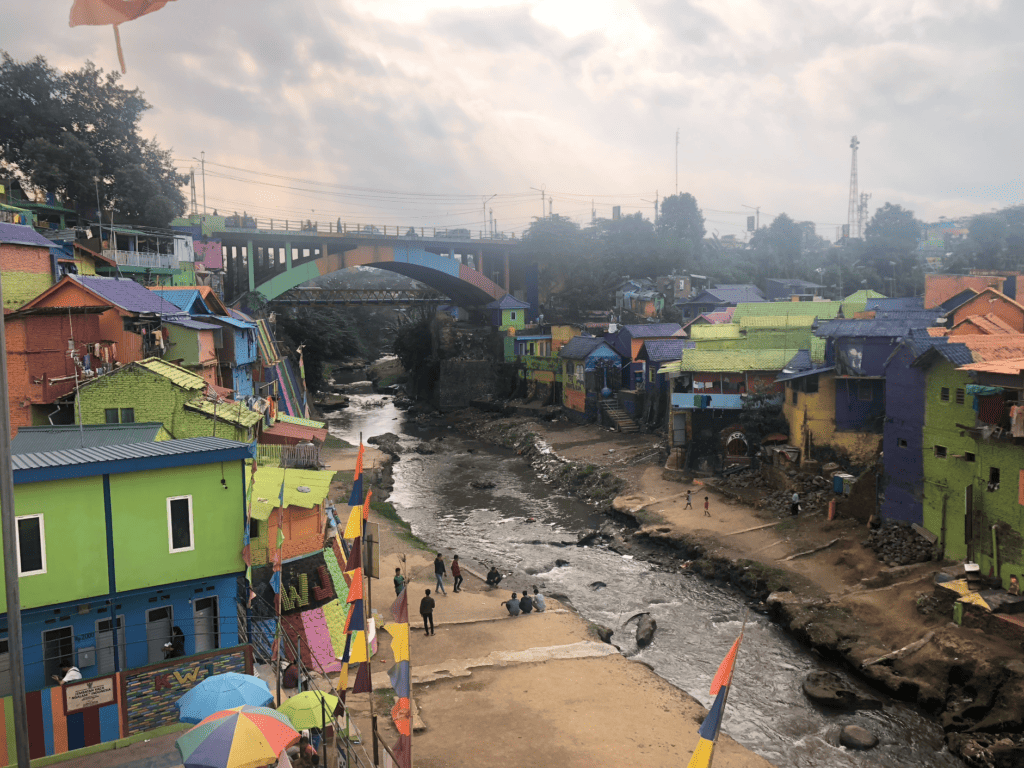
Day 8:
- Morning: Head to Batu to visit Tumbak Sewu and enjoy the best waterfall in Indonesia!
- Afternoon: Explore the charming atmosphere of Batu City.
- Evening: Enjoy the night at leisure in Malang.
Bromo Tengger Semeru National Park – Sunrise Over Volcanic Majesty:
Next on our East Java itinerary is Bromo. Enter the surreal landscapes of Bromo Tengger Semeru National Park, where the mystical Mount Bromo rises from the Sea of Sand. The pre-dawn trek to witness the sunrise unveils a breathtaking panorama, creating a spiritual connection with the volcanic majesty.
I didn’t have time to trek Bromo on my East Java Itinerary, but all those I’ve spoken to said it was magnificent, and it is certainly on my bucket list for next time!
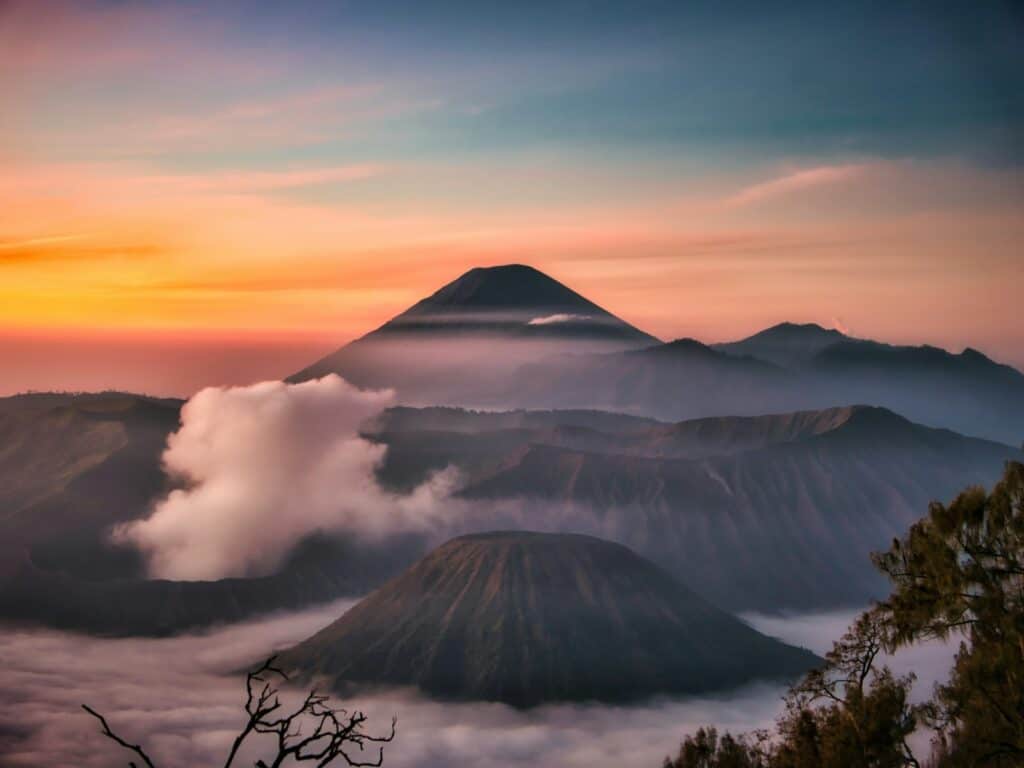
Accommodations:
– Luxury Option: Plataran Bromo (Very few hotels take my breath away, and this is one of them!)
– Budget Option: Bromo Otix Guest House
Day 9:
- Morning: Travel to Cemoro Lawang, the base for Mount Bromo.
- Afternoon: Check into your accommodation and rest for the early morning ascent.
Day 10:
- Pre-dawn: Embark on a sunrise trek to Mount Bromo for a breathtaking panoramic view.
- Good morning. Explore the Sea of Sand and the Bromo crater.
- Afternoon: Return to Cemoro Lawang for relaxation.
- Evening: Savor local cuisine at a nearby restaurant.
Mount Bromo (Entrance: IDR 230,000):
- How to Get There: Fly into Juanda International Airport (SUB) in Surabaya. Hire a private car from Surabaya or join a guided tour to Cemoro Lawang, the gateway to Mount Bromo. Or get a train or bus from anywhere in Java.
Hidden Javanese Coastal Wonders
Now, instead of jumping straight from hiking one volcano to the next, take a breather and have a beach getaway just south of Malang.
You will be pleasantly surprised by the beauty of the Java coast. While neighbouring Bali gets all the rep as the best holiday destination, adding these to your list will add a lot of diversity to your East Java itinerary.
Explore the coastal wonders of East Java, starting with Persona Pantai Banyu Anjok, a serene beach surrounded by lush landscapes. Discover Pantai Dan Air Terjun, where cascading waterfalls meet the sea, creating a picturesque scene.
Also, Indahnya Pantai Tiga Warna is a stunning beach adorned with vibrant hues. These coastal gems showcase the diverse beauty that East Java has to offer, providing a serene and picturesque conclusion to your spiritual travel adventure.
Day 11:
After all that un-godly hour of hiking, you’ll need a few relaxing beach days; luckily, there are many beautiful beaches to explore.
The first is Persona Pantai Banyu Anjok and Pantai Dan Air Terjun, which are for a tranquil beach and waterfall experience. You can spend a whole day here exploring the area or just soaking up those sun rays.
Day 12:
Explore Indahnya Pantai Tiga Warna, another stunning beach.
Ijen Crater – Blue Flames and Ethereal Landscapes:
Saving the best experience till last! Our East Java adventure concludes on an unforgettable hike to Ijen Crater, where surreal landscapes and otherworldly experiences await. It’s easily one of the most jaw-dropping and unique travel experiences ever! This trek is what made me fall in love with East Java.
The pre-dawn trek was seriously tough. We left Banyuwangi at 2 am, reached the volcano base at 3 am, and faced a gruelling two-hour uphill climb. Relief at the summit was short-lived; we had to descend into the active volcano crater to see the blue flames! Gas masks and goggles were a must due to the potent sulfur.
The trek down was challenging, and the climb back up was even more challenging. Fatigue, sulfur scent, and pitch-black darkness – it was a race against time to catch the sunrise. I almost cried; it was such a tough morning. But reaching the summit made me forget it all, witnessing one of the most spectacular sunrises etched in my memory.
The reward of the mesmerizing blue flames amidst the volcanic depths made it all worthwhile. I’ll never forget the resilient sulfur miners too, who tackle this route daily, earning peanuts for their heroic efforts. They’re unsung superheroes, and their back-breaking work made me pause and appreciate all I have.

Day 13 – Travel and Rest Before Ijen!
Day 14:
- Pre-dawn: Begin your trek to Ijen Crater to witness the mesmerising blue flames.
- Morning: Explore the Ijen Crater – life changing sunrise.
- Afternoon: Return to Banyuwangi for some relaxation.
- Evening: Overnight stay in Banyuwangi.
Ijen Crater (Entrance: IDR 100,000):
- How to Get There: From Mount Bromo, travel to Banyuwangi. Ijen Crater is accessible by a 2-hour drive from Banyuwangi.
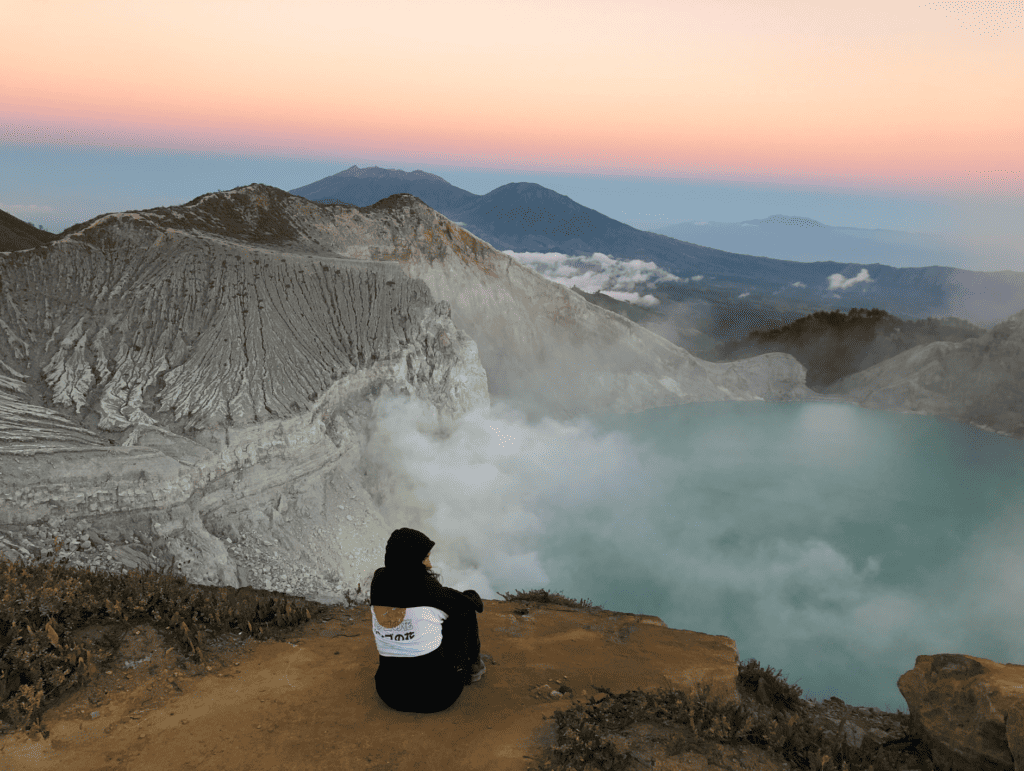
Banyuwangi – The Tranquil Finale:
As we reach the culmination of our East Java adventure, Banyuwangi emerges as the perfect finale, offering a serene retreat before and after the exhilarating Ijen Crater hike.
Nestled between the Bali Strait and the Indian Ocean, Banyuwangi welcomes you with diverse landscapes and authentic cultural experiences. Bali is a popular onward travel route for those on an East Java itinerary travel route.
Accommodations:
Luxury Option: Ketapang Indah Hotel
Budget Option: Banana Homestay
Day 15
- Good morning. Commence your day with the enchanting Jagir Waterfall, nestled in lush greenery. Immerse yourself in the traditional culture at Kampung Anyar, where the vibrant customs of Java come to life.
- Afternoon: Journey to the captivating Red Island (Pantai Pulau Merah) for its red-hued sands and coastal beauty
- Night: Experience the lively atmosphere at Blambangan Night Market, indulging in local delicacies and traditional crafts.
MORE: Off the Beaten Path East Java:
If you are feeling more adventurous, consider adding some of these lesser-known villages and places to your East Java itinerary. You will be immersed in local life and the culture here.
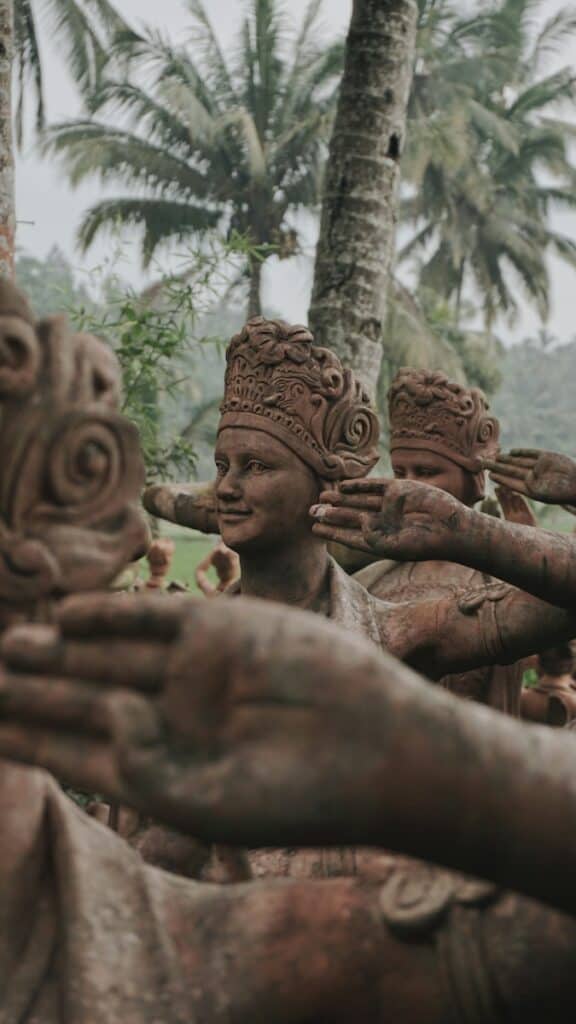
Kampung Tridi (3D Village):
Situated in Malang, Kampung Tridi is an immersive 3D art village where houses are painted with optical illusions. Visitors can interact with the art, creating unique photo opportunities in this offbeat destination.
Kampung Gunung (Mountain Village):
Nestled at the foot of Mount Bromo, Kampung Gunung offers a peaceful retreat with breathtaking views of the surrounding mountains. Experience local village life and enjoy the serenity away from the more touristy areas.
Madakaripura Waterfall:
Often overshadowed by other waterfalls in the region, Madakaripura is East Java’s tallest waterfall. Tucked in the Bromo Tengger Semeru National Park, the cascading water surrounded by canyon walls creates a magical setting.
Desa Ngadisari (Ngadisari Village):
A charming village near Mount Bromo, Ngadisari provides a glimpse into rural Javanese life. Surrounded by lush landscapes, this village offers a peaceful getaway and serves as a gateway to the iconic volcano.
Using Kemiren Village:
Nestled in the hills near Banyuwangi, Osing Kemiren Village is inhabited by the indigenous Osing people. Explore their unique customs and traditional houses, and witness traditional arts performances in this cultural enclave.
Pacitan Caves (Goa Gong):
In Pacitan, discover the mesmerising Goa Gong, an intricate cave system featuring stunning stalactite and stalagmite formations. This underground wonder is off the typical tourist trail and offers an adventure for cave enthusiasts.
Red Island (Pantai Pulau Merah):
Escape to Red Island, a hidden coastal paradise near Banyuwangi. This unspoiled beach boasts red-hued sand and offers a tranquil setting for those seeking a less crowded coastal experience.
Tumpak Sewu Waterfall:
Known as the “Thousand Waterfalls,” Tumpak Sewu is a hidden gem in Lumajang. Surrounded by lush jungles, the waterfall creates a captivating scene. It is less frequent compared to other waterfalls in the region.
Onwards Travel to Bali or Lombok:
After you have completed your East Java itinerary, consider island hopping to neighbouring islands such as Lombok or Bali. These islands can easily be accessed through airport or ferry, and I highly recommend visiting these small but mighty islands!
Onwards Travel to Bali:
How to Get There:
Short flights from Surabaya or Yogyakarta to Ngurah Rai International Airport (DPS) in Bali are available. Or overland transport, such as a bus or train to the ferry port in Banyuwangi. Cross the Bali Strait, then take a bus to your chosen destination in Bali.
Read our Bali Itineraries: 3-Weeks in Bali, 5-Days in Bali, Spiritual Things to Do in Bali & Tours in Bali!
Places to Stay:
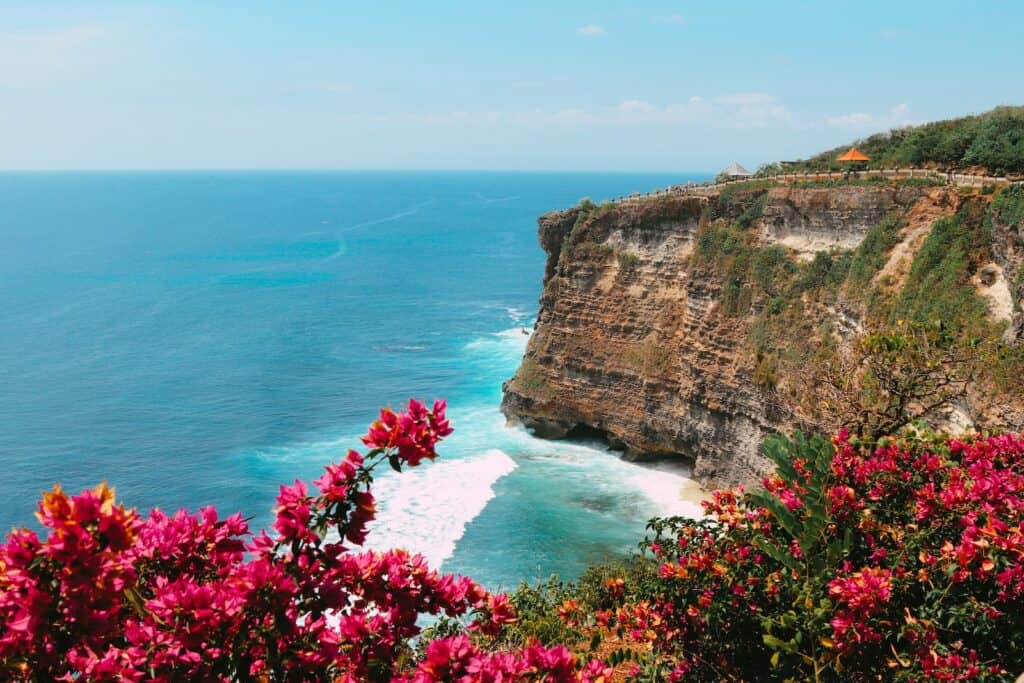
Onwards Travel to Lombok:
How to Get There:
Ferries operate from Banyuwangi to Lembar in Lombok. Or fly from an airport in Java. You can also get the ferry across to Bali, travel by bus to Sanur and get another ferry (5hours) Alternatively head to the ferry port of Padang Bai in Bali and catch a fast boat (1.5 hours)
Places to Stay:
- Kuota
- Gili Islands
- Mount Rijiani
- Tanjung Ringgit Peninsula (Lombok Pink Beach)
East Java Itinerary Conclusion
Planning a trip to East Java offers a gateway to diverse and exciting adventures. Whether exploring the historic streets of Yogyakarta, browsing Surabaya’s vibrant markets, or uncovering hidden gems across the region, each experience enriches your journey through East Java.
Your carefully planned itinerary will guide you through breathtaking landscapes like Bromo Tengger Semeru National Park, the fascinating Ijen Crater, and the scenic beaches of Persona Pantai Banyu Anjok and Pantai Dan Air Terjun. These destinations highlight East Java’s rich cultural heritage and stunning natural beauty.
Venturing into lesser-known villages such as Jodipan and Osing Kemiren reveals the authentic charm of East Java, offering a deeper connection with the region that goes beyond the typical tourist spots.
From Surabaya’s bustling streets to Bromo’s serene surroundings, every stop along your trip contributes to a memorable and well-rounded adventure. It’s not just about the places you visit; it’s about immersing yourself in the diverse cultures, flavors, and landscapes that make East Java truly unique.
Ultimately, your East Java itinerary is more than a list of destinations—it’s a celebration of the joy of travel. Each thoughtfully chosen experience will help create a journey you’ll remember forever. So, embark on your East Java adventure with the confidence that every step, every village, and every sunrise will leave you with unforgettable memories.
1. What are the top things to do in Java Island?
When exploring Java Island in Indonesia, don’t miss out on visiting the East Java region. Key highlights include witnessing the majestic Mount Bromo, the stunning Ijen Crater, and the cultural richness of Yogyakarta. For a complete Java in Indonesia itinerary of days, include these iconic sites to experience both the natural beauty and historical significance of the island.
2. How can I travel from Bali to Java?
To get from Bali to Java, you can take a ferry from Bali to Ketapang in East Java. Alternatively, flights are available from Bali to Surabaya or Malang in Java. For a smoother experience, check schedules and book tickets in advance. This travel option makes it easy to integrate Java into your week itinerary in Indonesia.
3. Is it safe to travel to Java, Indonesia?
Yes, it is generally safe to travel to Java, Indonesia, including the East Javanese regions. However, always check travel advisories and follow local guidelines. While exploring the Java island in Indonesia, be mindful of natural hazards like volcanic activity and ensure you stay updated on time in Java, Indonesia for your travel planning.
4. What is the best time to visit Java Island?
The best time to visit Java Island is during the dry season, from May to September. This period provides pleasant weather, ideal for exploring the East Java island and other parts of the island. Avoid the rainy season to fully enjoy top things to do in Java and your planned days in Indonesia.
5. How many days should I spend on Java Island?
A well-rounded Java in Indonesia itinerary typically spans 5-7 days. This allows ample time to explore highlights such as Mount Bromo, Ijen Crater, and cultural sites in Yogyakarta. Depending on your interests, you might adjust your days in the east to focus more on specific regions like Jawa Timur East Java.
6. How do I include Java in my Bali itinerary?
To include Java in a Bali itinerary, you can plan a 10-day trip where you spend a few days in Bali and then transfer to Java. Utilize a combination of flights and ferries to travel between the islands. This approach ensures you experience the best of both Bali and Java, maximizing your week itinerary in Indonesia.
- The Gunung Padang Megalithic Site: Uncovering New Depths of History
 The fascinating UNESCO World Heritage Gunung Padang Megalithic Site stands as an enigmatic relic of a bygone era, shrouded in mystery and controversy. Nestled…
The fascinating UNESCO World Heritage Gunung Padang Megalithic Site stands as an enigmatic relic of a bygone era, shrouded in mystery and controversy. Nestled… - Best Pilgrimage Routes in Europe: 31 Wonderful Journeys of Faith
 Want to embark on some Life-Changing Pilgrimage Routes in Europe? We have 31 show-stopping trials to inspire you today. Amid our hectic lives, a…
Want to embark on some Life-Changing Pilgrimage Routes in Europe? We have 31 show-stopping trials to inspire you today. Amid our hectic lives, a… - Best Spiritual Tours in Nepal: The Most Epic, Beautiful and Life-Changing Tours!
 Embarking on a spiritual tour in Nepal promises a profound and transformative journey. When I visited the Everest region for one month to hike…
Embarking on a spiritual tour in Nepal promises a profound and transformative journey. When I visited the Everest region for one month to hike… - The Best Sustainable Eco-Tourism Places to Stay in Mexico 2024 – Beautiful & Unique Stays
 Looking for the Best Eco-Tourism Places to Stay in Mexico? Well, we have got you covered. The quest for sustainable travel experiences has never…
Looking for the Best Eco-Tourism Places to Stay in Mexico? Well, we have got you covered. The quest for sustainable travel experiences has never… - How To Plan an Epic Budget-Friendly Trip to Southeast Asia
 Are you looking for tips on how to plan a budget-friendly trip to Southeast Asia? We’ve got you covered. Budget travel is all about…
Are you looking for tips on how to plan a budget-friendly trip to Southeast Asia? We’ve got you covered. Budget travel is all about… - Sustainable Tourism Options in Mexico – An Implementation of Hope
 Are you wondering if there are sustainable tourism options in Mexico? Well, the answer is yes, absolutely! Mexico is forthcoming in sustainable and eco-tourism,…
Are you wondering if there are sustainable tourism options in Mexico? Well, the answer is yes, absolutely! Mexico is forthcoming in sustainable and eco-tourism,…

